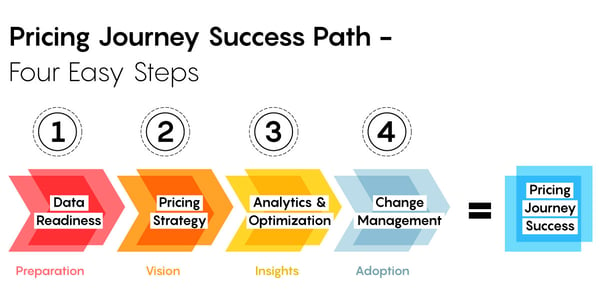When I give presentations I sometimes use the concept of a lemonade stand because I’ve found it to be an effective yet simple way to explore the challenges retailers face when executing pricing decisions, embracing price optimization and finding ways to make strategic pricing decisions profitable.
A few years ago, the audience’s response prompted a trip down memory lane to my first days as a pricing analyst many years ago. Back then I tried my best to embrace pricing analytics and evangelize a new concept in an organization that was not ready for change. At the time I didn’t know but I was about to embark on my own pricing journey.
A decade and a half later, many retailers are starting their own pricing journeys – ones designed to unearth incremental margin gains, competitive advantage and increased revenues. But there are many roadblocks making succeeding difficult. These are the most common:
- Poor data quality and insufficient data
- A pricing strategy that's reactive instead of proactive
- Limited analytical techniques and skill sets
- A lack of clear measurements for adoption
Roadblocks happen, but I know a path for pricing success, one that’s worked well for the companies I've supported along the way. This four step process tackles roadblocks, averts challenges and helps make achieving success quick and easy.

Step One: Data Readiness
Data readiness requires a great deal of courage and sometimes even a leap of faith. This stage elicits sighs, cowering and trembling among even the greatest organizations. The proverbial “garbage in, garbage out” always comes up, because as we know all too well – you're only as good as your data. Right?!
Fortunately, the many advances in data readiness better harmonize, profile and store data across many, disparate sources. Managing big data has never been easier with developments like Hadoop or event stream processing. Data is your most precious asset. And by leveraging it fully, you can improve competitive insights, understand customer satisfaction and provide personalized offers to customers in localized markets and channels. The data readiness stage is all about meaningful preparation. Preparation prompts perspiration, but perspiration breeds success! The hard work you put in here pays off handsomely.
Step Two: Pricing Strategy
After data readiness, pricing strategy is the most critical step on your journey to success. Beyond setting lofty corporate goals, this step is about establishing a strong ‘pricing foundation.’ What are your product's pricing roles? Are they basket builders, margin drivers or value offers, etc.? What is your test and learn approach to measuring strategy success? Pricing strategy employs data-driven insights to set the vision for how analytics and optimization will be applied, along with measurable results, so as to realize adoption. Vance Havner says it plainly, “The vision must be followed by the venture. It is not enough to stare up the steps - we must step up the stairs.”
Step Three: Analytics & Optimization
This step is likely the easiest. Once your data is ready and your strategy is clear, you can apply modeling, forecasting and pricing analytics, yielding the insights you seek. Scenario analysis is vital for understanding competitive advantage, financial risks, opportunities to localize and how to best tweak your goals and targets to maximize outcomes. Embracing the pricing lifecycle, and quantifying its impact along the way, is the greatest opportunity in this stage. Nowadays, price sensitivity, promotion lift or setting the right markdown price is not enough. You must provide a pricing experience that aligns to your customers’ shopping experience, product timing and channel demands seamlessly. And with predictive and prescriptive analytics, you can make this happen.
Step Four: Change Management
Change management, your last step, may be your trickiest without a clear pathway for adoption. But adoption is easier said than done and even as you begin impacting merchandising and operations processes, demonstrating profitability isn’t enough. The four steps I’ve outlined here ensures you’re creating a better enterprise data model for your end users. You’ll have an improved strategy with a clearer vision. And as you apply analytics to understand impact and garner new insights, you’ll have the evidence to encourage improved adoption. I always recommend starting small. Build evangelists from within and ensure there are measurable milestones every step of the way. Change is inevitable and when fear is extinguished and measurable results begin, adoption is won!
I’ll discuss these steps in more detail over the next few weeks. Stay tuned!


